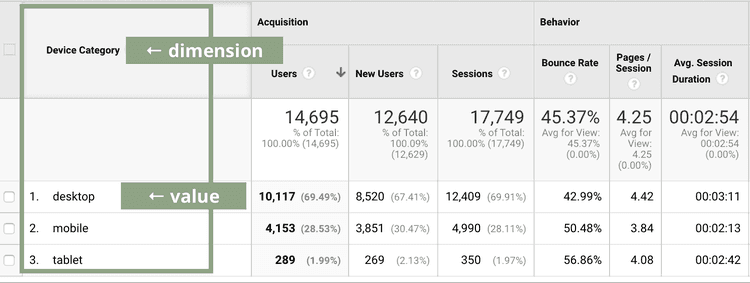Described: The Role and Interpretation of a 'Secondary Dimension' in Google Analytics
Described: The Role and Interpretation of a 'Secondary Dimension' in Google Analytics
Blog Article
Introducing the Intricacies of Second Measurement in Google Analytics: a Comprehensive Overview on Exactly How It Works
Navigating the elaborate world of second dimensions in Google Analytics is a task that requires an eager understanding of how this attribute runs within the system. As electronic landscapes progress and data comes to be significantly essential for decision-making, comprehending the subtleties of secondary measurements can be the trick to unlocking valuable understandings.
Basics of Secondary Measurement in Google Analytics
When examining data in Google Analytics, utilizing the second dimension attribute gives useful insights into the efficiency of numerous metrics. The secondary dimension permits individuals to additionally explore their data by including an additional layer of details to their main measurements. By doing so, experts can acquire an extra comprehensive understanding of the elements affecting their website's efficiency.
In Google Analytics, the key measurements stand for the primary groups of information, such as traffic resources or tools. When an additional measurement is used, it provides a much deeper degree of granularity by showing an additional element of the data within the picked key measurement. If the key dimension is 'Website traffic Source,' including a second dimension like 'Landing Web page' can reveal which specific pages are driving traffic from each source.
This function is specifically helpful for recognizing patterns, correlations, and fads that may not be immediately obvious when looking at the information from a solitary measurement. By leveraging the second dimension in Google Analytics, users can discover beneficial insights that can notify tactical choices and optimizations to improve web site performance.
Establishing Secondary Measurement Reports
Broadening on the insights acquired via the application of second measurements in Google Analytics, the process of setting up secondary measurement reports includes setting up additional layers of data to additionally improve the depth of evaluation. Once the key report is selected, users can click on the "Additional measurement" tab situated over the information visualization location. From there, a drop-down menu will appear, supplying a variety of options to select the second measurement that finest matches the key data collection.
Leveraging Secondary Measurements for Insights
Using second dimensions in Google Analytics offers a critical technique to drawing out nuanced insights for educated decision-making in on-line company optimization. By combining key dimensions with second dimensions, companies can delve much deeper right into their data to reveal beneficial correlations and patterns that may not be promptly evident. By segmenting internet site traffic by geographical area (key measurement) and after that including a secondary dimension like tool category, businesses can determine if specific areas choose accessing the website using mobile or desktop.
Moreover, leveraging secondary measurements permits organizations to obtain a much better understanding of user behavior and preferences. Assessing conversion prices based on website traffic sources (main dimension) along with the secondary measurement of touchdown web pages can disclose which details web pages are most reliable in driving conversions for natural search web traffic versus social media web traffic. These insights can then inform marketing strategies and site optimization efforts to boost general efficiency and make the most of ROI.
Advanced Strategies for Second Dimensions
To further remove complex insights and enhance data-driven decision-making within Google Analytics, applying innovative strategies for making use of second measurements is crucial in unlocking much deeper layers of valuable information for service optimization. One advanced method is the use of custom dimensions and metrics, allowing for the monitoring of specific individual communications or behaviors that are not captured by default in Google Analytics. By implementing and specifying customized measurements, companies can customize their tracking to line up with unique business objectives and purposes.
An additional innovative strategy entails making use of filters in conjunction with secondary measurements. Filters allow individuals to improve the information presented in Google Analytics records, providing more targeted and appropriate understandings. By using filters strategically with second dimensions, businesses can segment data extra successfully, causing a clearer understanding of customer actions and performance metrics.

Optimizing Information Analysis With Secondary Measurements

In addition, optimizing data analysis with secondary dimensions includes try out different combinations to identify patterns and relationships that may not be promptly obvious. This repetitive approach allows analysts to fine-tune their coverage and emphasis on one of the most appropriate information factors for their company purposes. Ultimately, by leveraging second dimensions effectively, analysts can enhance the precision and performance of their data analysis efforts in Google Analytics.
Conclusion
In final thought, understanding the details of additional dimensions in Google Analytics is important for obtaining deeper understandings right into internet site efficiency. By establishing second dimension reports, leveraging them for understandings, and making use of advanced strategies, experts can maximize information evaluation and make notified visit choices. This thorough guide has given a comprehensive overview of exactly how additional dimensions job and their relevance in improving the logical abilities of Google Analytics customers.
The additional dimension permits customers to even more study their data by adding an additional layer of info to their key dimensions. When a secondary measurement is used, it offers a much deeper level of granularity by showing one more aspect of the data within the picked primary dimension.Increasing on the understandings obtained via the application of additional measurements in Google Analytics, the procedure of establishing up secondary dimension records involves setting up added layers of information to even more boost the depth of evaluation. By incorporating key dimensions with secondary dimensions, services can dive much deeper into their data to discover beneficial correlations and patterns that may not be right away noticeable. One this post way to enhance information evaluation with second measurements is to incorporate them with key measurements to obtain an extra extensive sight of site efficiency.
Report this page